A story that’s stranger than fiction
A few days ago, El País dropped a mind-bending investigation: Jianwei Xun, a so-called Chinese philosopher behind the viral “hypnocracy theory,” doesn’t exist. The articles, citations, and philosophical musings attributed to him? All AI-generated, crafted with surgical precision by anonymous creators who embedded Xun in public discourse as if he were a real academic voice. The plot was so convincing it fooled journalists, scholars, and even Wikipedia editors.
Let that sink in: we now live in a time where fictional thinkers can have real influence, not in novels or films, but in news headlines and academic citations.
At first glance, this seems like a cautionary tale about misinformation or academic gatekeeping. But something else caught my attention.
It wasn’t just the deception that was impressive. It was the skill behind it. The way AI was wielded not as a tool, but as a medium. This wasn’t about fabricating a Wikipedia page. It was about crafting a believable intellectual presence, complete with a “theory,” a body of work, and digital aura. Whoever made Jianwei Xun wasn’t just faking, they were performing a kind of creative authorship that’s only possible if you really know how to speak fluent AI.
And that, I think, is the bigger story.
AI dexterity is becoming a creative talent
We’re entering a time where the ability to use AI ( to prompt it, sculpt it, remix and direct it) is beginning to resemble a kind of creativity. Not in the “press a button and it makes a thing” sense, but in the same way that drawing, writing, or composing have always required practice, intuition, and skill.
Some people are already developing an ease with AI tools, the ability to think in prompts, sense the limits of models, and coax out compelling results. They’re not just using AI; they’re designing with it. And that talent, like any creative gift, is becoming admired, followed, and sought after. It’s a shift I’ve been pondering about AI in design education, is AI use becoming a craft to be nurtured, a skill to be taught, or simply a productivity shortcut? Meanwhile, others are choosing not to engage.
Or they try and don’t “get it.”
Or they don’t see the point.
This divide, between AI-dexterous creatives and those who aren’t, could become as culturally loaded as the difference between people who are seen as “naturally talented” and those who are not.
And we’ve been here before.
In every creative field, from painting to music to design, some people have been valorised for their craft while others have been excluded, ignored, or seen as lacking that elusive spark. But we know talent isn’t magic. It’s nurtured, practiced, scaffolded. The same must become true of AI creativity.
If not, we risk creating new hierarchies of access and prestige, where “AI fluency” becomes a marker of intellectual or professional worth, without necessarily challenging how that fluency is taught, shared, or critiqued.
What this means for designers, educators, and researchers
So where does this leave us? Especially those of us working in design, education, or knowledge-making fields? A few provocations to ponder:
We need to treat AI creativity as a teachable craft.
If prompting, editing, and curating AI outputs is becoming a new form of cultural production, then we can’t leave it to chance. Just as we teach design students how to iterate, reflect, and critique, we need to teach them how to use AI with the same rigour.
Originality is becoming collective.
The idea of the lone genius is being unsettled, not just by collaboration with other humans, but by co-creation with AI. A beautifully crafted output might be less about who made it and more about how it was directed. That doesn’t diminish creativity. It just makes it more layered.
Credibility needs new checks and balances.
In a world where fictional philosophers can trend on Twitter, we need better ways to evaluate ideas beyond who supposedly said them. This means looking at argumentation, evidence, and critical framing, not just authority by name or publication.
Practicing AI is a way of thinking.
Prompting isn’t mechanical. It involves empathy, clarity, curiosity, and the ability to reframe. That’s not unlike design thinking, and we should embrace that overlap. AI can stretch our cognitive muscles, not replace them.
“AI is not just a tool to use. It’s a medium to think with.”
Let that be our mantra moving forward.
So whether you’re designing futures, mentoring students, or just trying to stay afloat in a sea of AI hype, remember: learning to think with AI isn’t just a technical skill. It’s a creative practice. And like any creative talent, it’s yours to cultivate.

